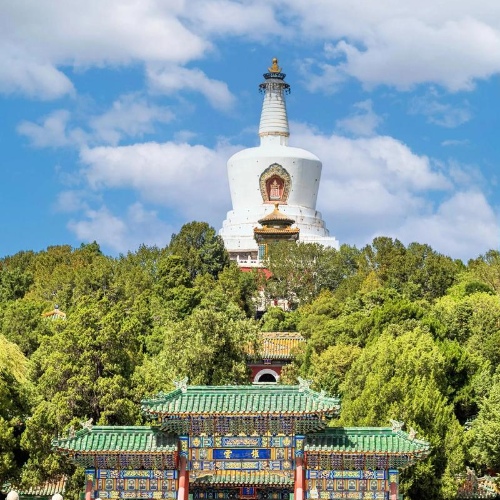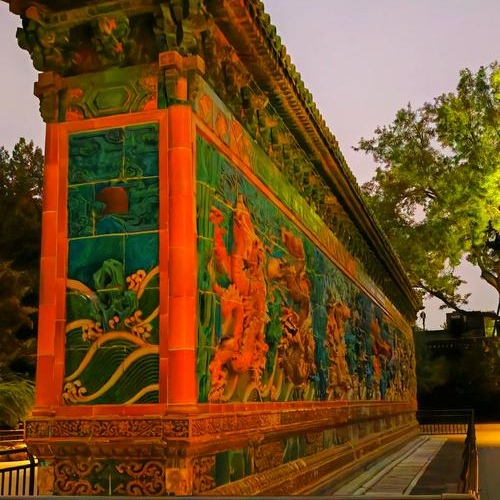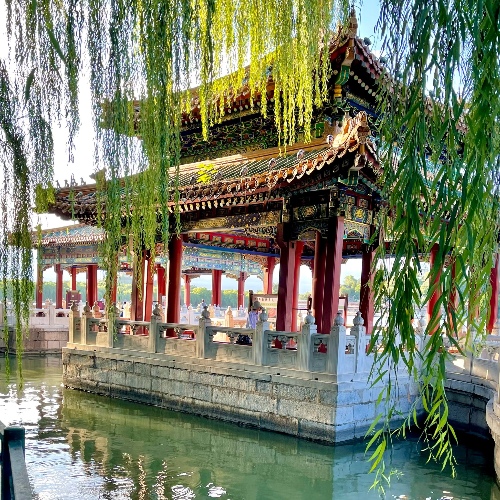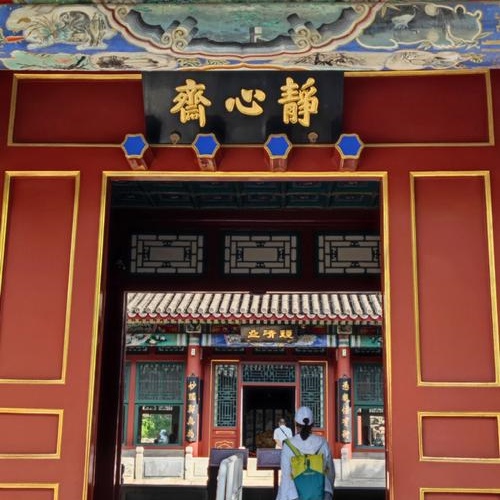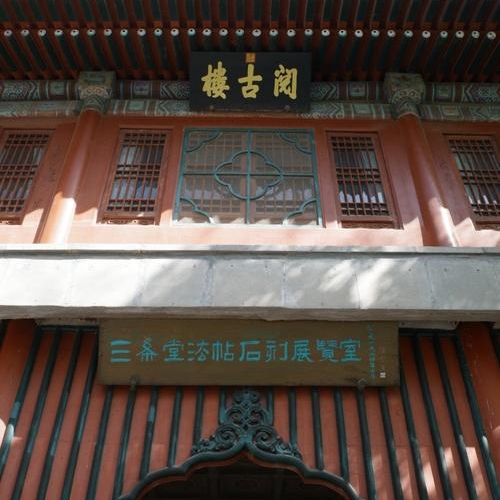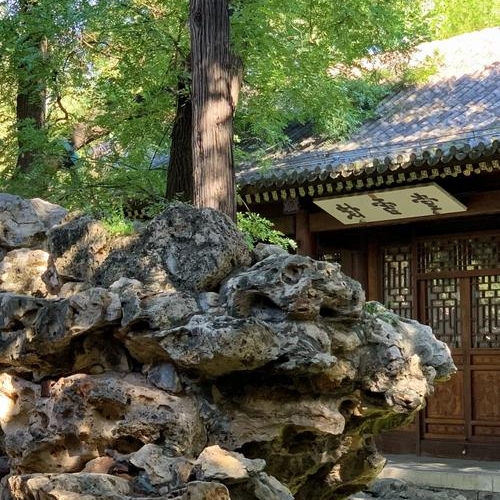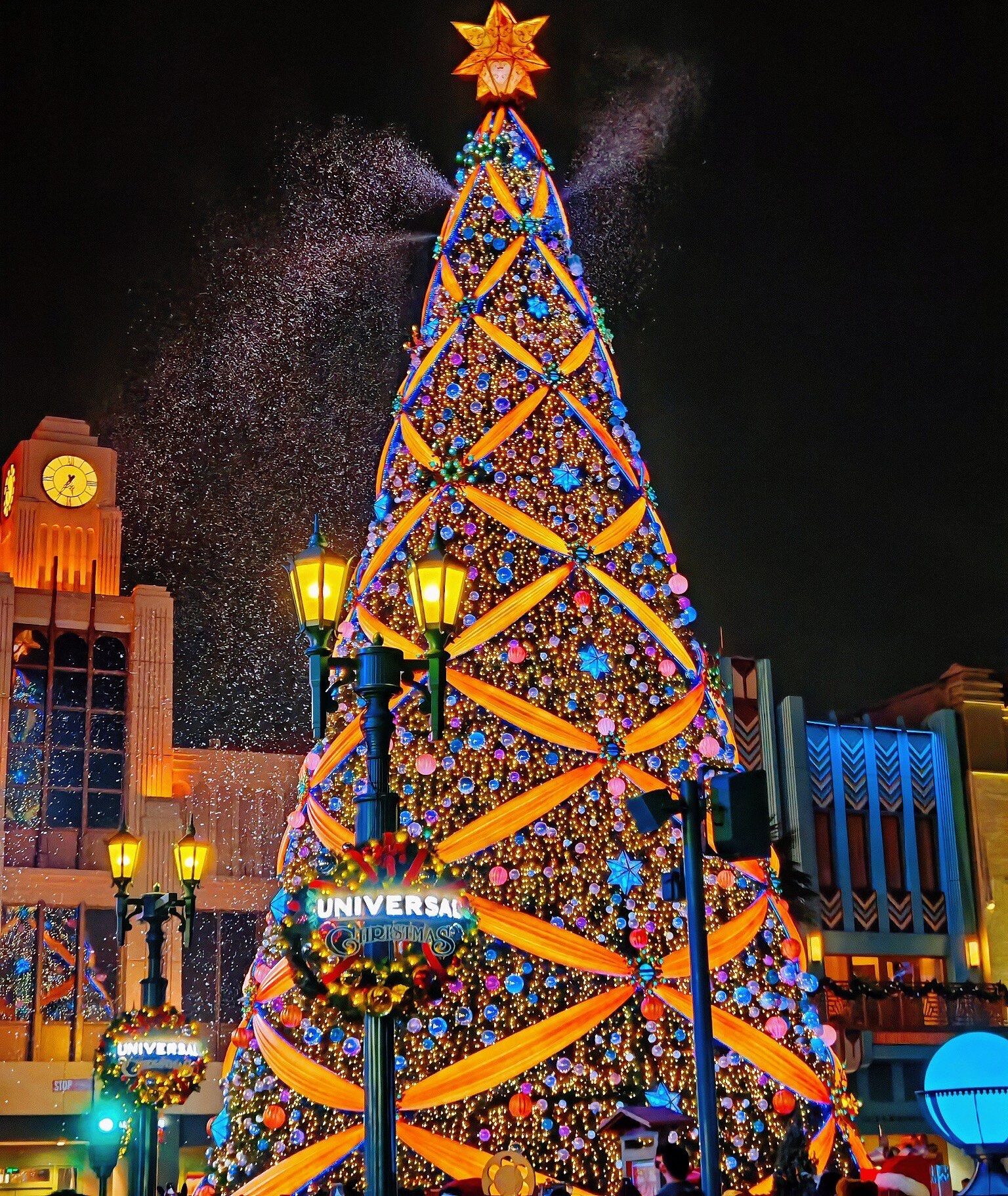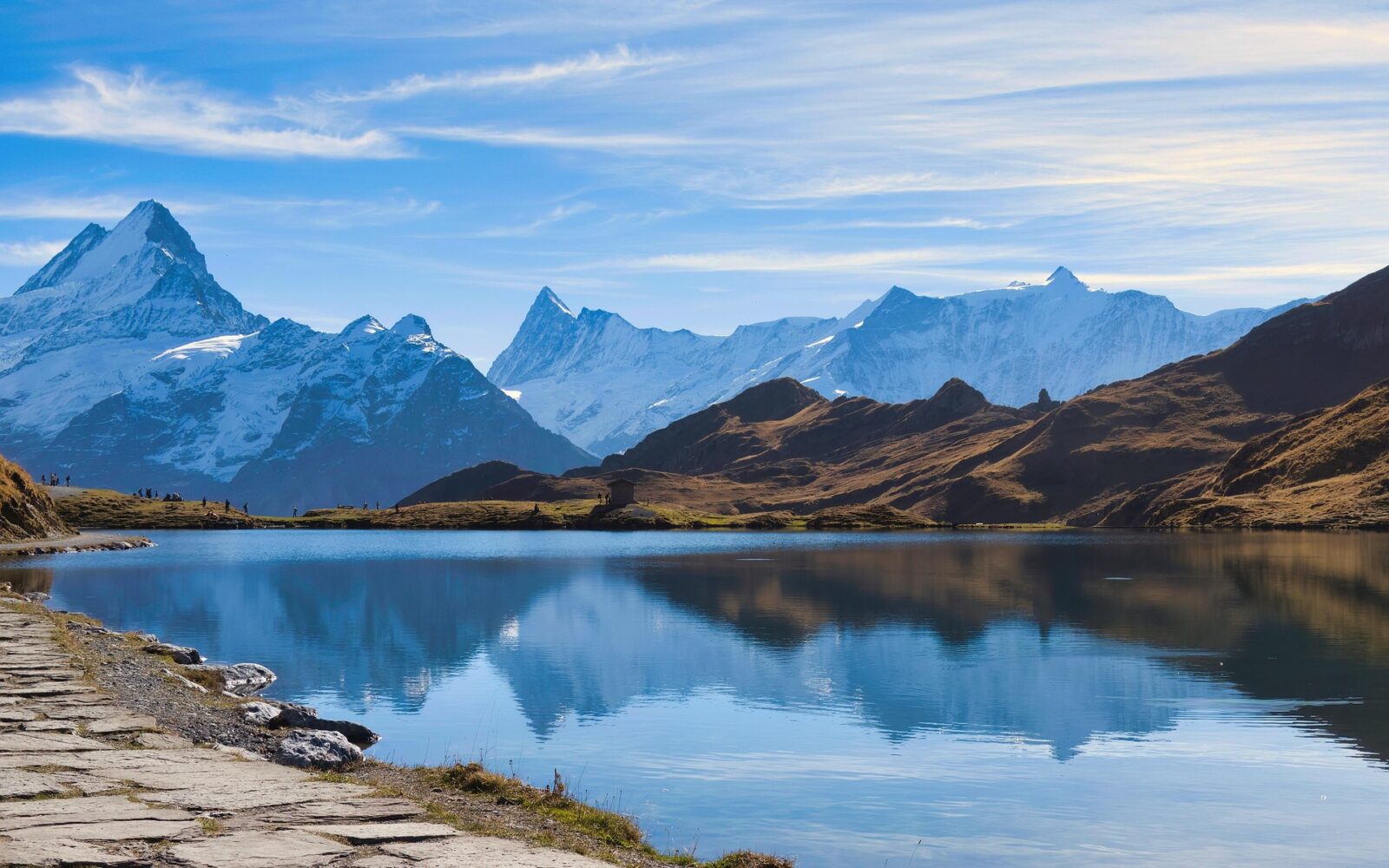If you find yourself in search of royal treasure hidden near the Forbidden City, or are simply craving somewhere tranquil to escape Beijing’s crowds, Beihai Park is your answer. This 1,000-year-old imperial garden attracts locals for sunrise tai chi and photographers there to nail golden-hour White Pagoda shots. Boat on its lake, and you’ll find ancient pagodas mixed with modern skyscrapers — a view of Beijing’s Chinoiserie unmatched elsewhere.
Unlike some of the busier places, Beihai brings a quiet royal charm and Jiangnan-style beauty at Huafang Studio (think spring crabapple blossoms). Hike Jade Flower Island rock, admire the glinting scales of the Nine-Dragon Wall or sup at a tea house as the sun flares orange on the water. It’s where the royal Beijing of yore converges with everyday calm — a must on your itinerary for 2025.
Inside Beihai Park: What’s Waiting Beyond the Gates?
- White Pagoda
- Nine-Dragon Wall
- Five-Dragon Pavilions
Jadeflower Island--Where the White Pagoda goes beyond the Sky
The centre point of Beihai Park is Jade Flower Island, topped by the 36m-high White Pagoda. The sun catches its white body and blue-glazed roof. The climb takes about 15 minutes, and at the top you can see Jingshan Park, the golden roofs of the Forbidden City and Taiye Lake stretching below. It’s just magic, especially at sunrise or sunset when the lake is aglow with a golden light.
The Dragon Light Purple Shine Archway provides bright contrast on the ground, with red pillars and blue tiles. One of the most photographed spots in the park, it’s ideal for visitors looking to capture a classic Chinese scene. The area is closed after 17:00 so plan your trip for the shots in their evening aspect.
Round City – The Miniscule Fortress of Jade and History
Amid such calm, Round City feels like a secret tucked away behind Beihai. Inside, in the holy hall, there is a mysterious scene: The 1.6-meter highover Jade Buddha from Burma emits a serene light. Nearby is the 3,500-kg Dushan Jade Vessel, sculpted with a single block of black jade—a throwback to China’s ancient artistry. A natural canopy for self-reflection is provided by the Shady Marquis Pine, a more than 800-year-old tree that extends its branches above the courtyard.
I thought of Round City as the perfect place for slowing down. It is by the South Gate, so easy to visit before or after seeing other parts of the city. The soft buzz of the city recedes at this point in, as does the sound of wind through pine needles and the occasional clanging temple bell.
Nine-Dragon Wall: The Fiery Colors of Imperial Power
The Nine-Dragon Wall is also interesting with 424 glazed tiles and 32 dragons winding through its surface. The lights of yellow, green and blue radiate as the afternoon light hits around 4 p.m., making for a nearly living tableau. A dragon for each may also symbolize imperial power and good luck, images once believed to guard the royal gardens.
It was easy to compare it against the ones in Pingyao and Datong, which we had visited earlier. Beihai’s version has a quality that is somehow more intimate, closer to the viewer perhaps in focus or attitude — as if the dragons might suddenly leap out at us. Stop by the nearby rest area or check out Xitian Fanjing, just down the road, after your visit.
Huafang Studio – The Garden in the Garden
Huafang Studio — one of Beihai Park’s quietest corners and particularly lovely in spring. The crabapple blooms here can be on par with cherry blossoms, their pink petals strewn across the water like confetti. It’s a “get lost and dream” kind of place with Jiangnan-style bridges, meandering pathways and rockeries that form a meditation worthy scene for both shutterbugs and scientists.
I dropped by early one morning with coffee in hand. The songs of birds and rippling water was all that broke the silence. It’s the sort of place that makes you linger longer than intended. Look up “Huafang Zhai” on maps — it’s hard to spot but worth the walk.
Five Dragon Pavilions: Where the West Lake Gets Painted by Sunset
If you would like to see Beihai Park at its prettiest, be sure to visit the Five-Dragon Pavilions as the sun sets. The red columns and green rooftops are mirrored in the lake, a postcard image if ever there was one. I hired a pedal boat (120 RMB/hour for four people) to see the reflection of the White Pagoda glow in the distance; it was like stepping straight into an antique painting.
Mornings, this is where the locals practice tai chi and song. I came once, copying their steps like a rude child, and they greeted me with laughter. And that combination of community and landscape is what makes this park memorable. Boat rentals shut down around 6 in summer, so get there in time for golden hour before the light is gone.
Curious which parks show China’s natural beauty best? Read Must-See 12 Parks in China Insider’s Guide 2025
Hidden Corners of Beihai Park Worth Visiting
- Jingxin Zhai
- Yuegu Building
- Kuaixue Hall
Jingxin Zhai – Quiet Heart Studio
Jingxin Zhai sits like a hidden retreat inside Beihai Park, perfect for those seeking calm. The small bridges and still lake create a poetic balance that feels far from city rush. Mornings bring golden light over lotus flowers, and the air smells faintly of damp stone and pine. Visitors often come here to paint, practice meditation, or sip tea by the water. It’s a quiet gem that invites reflection, especially if you visit early when the crowd is thin.
Entrance is free with the park ticket, and you’ll spend little except for tea or snacks nearby—around 30–50 RMB. Bring a small sketchbook or a camera; this is where peace and light meet. Locals say it’s their favorite corner to “think slowly.” That’s reason enough to stop by.
Yuegu Building – The Calligraphy Lover’s Secret
Yuegu Building blends history and art with a scholar’s grace. Inside, the stone tablets display centuries of Chinese calligraphy, each stroke sharp with emotion. On weekends, local artists host calligraphy shows here; you can watch them grind ink and write on silk fans. The hall feels timeless, echoing softly with the sound of brushes and quiet admiration.
Tickets are included in the park’s combined pass. Plan to spend about an hour here—more if you join a workshop. It’s best to visit after lunch when sunlight cuts through the lattice windows. For around 60 RMB, including tea and a fan souvenir, you’ll walk away inspired and relaxed.
Xitian Fanjing – Beihai’s Peaceful Temple
Xitian Fanjing stands as a sanctuary for peace-seekers. The golden roofs gleam through trees, and incense floats gently in the air. Monks chant softly in the mornings, setting a calm rhythm that travelers often join by offering incense. Every statue here tells a story of compassion and balance, reminding you why Beihai feels more spiritual than grand.
Admission is free, but a small incense offering costs about 10 RMB. Visit around 9 AM for morning prayers or at sunset for photography. Whether you come for faith or stillness, the temple’s atmosphere makes it unforgettable. Bring a respectful heart and leave your noise behind.
Kuaixue Hall – For Tea and Ancient Stones
Kuaixue Hall is both an art corner and a resting place. The Snowy Cliff Stone outside carries imperial calligraphy carved centuries ago, while inside, tea masters serve jasmine or oolong tea. It’s common to see locals sketching or reading, turning a simple cup of tea into a ritual. During spring, peonies bloom, making the whole place smell like a soft breeze.
For about 80 RMB, you can enjoy a tea set with desserts while listening to light zither music. Come in the afternoon when the sunlight hits the windows and paints everything gold. This stop gives travelers more than flavor—it gives them pause.
The Quiet Magic of Beihai Park: Where the City Takes a Deep Breath
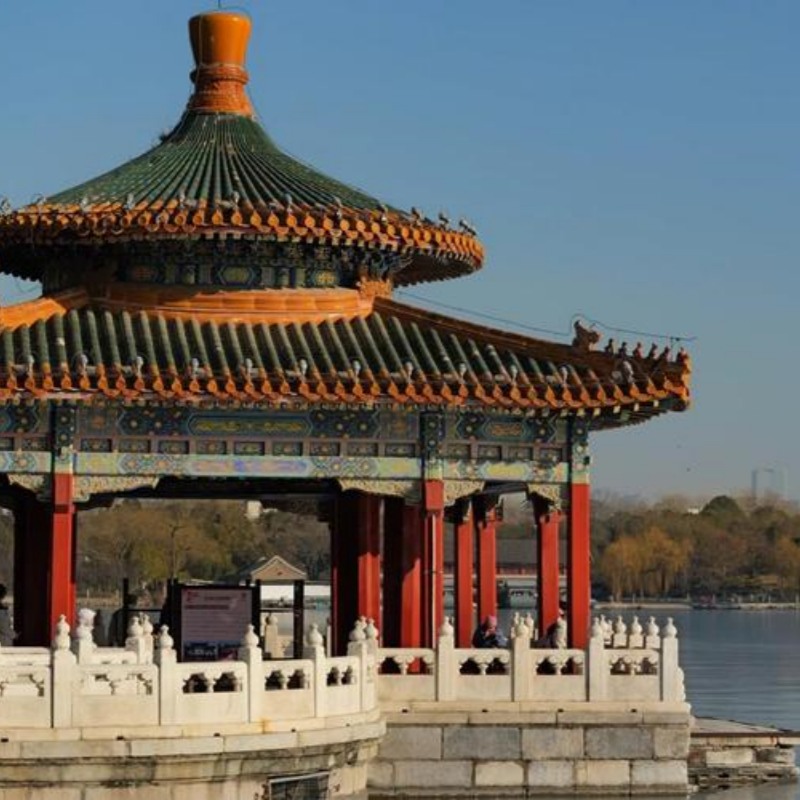
Beihai Park
Beihai Park isn’t your typical tourist spot. It’s the kind of place where time slows down, where locals smile as they pass, and where the air somehow feels softer. People in Beijing often say the park has “energy” — not the mystical kind, but a calm, grounding vibe that seeps into you if you let it. Maybe it’s the way sunlight hits Taiye Lake or how the White Pagoda’s reflection trembles on the water. Whatever it is, you leave lighter than when you came.
Where the Good Energy Comes From?
Part of Beihai’s pull comes from its royal past. For over a thousand years — through the Liao, Jin, Yuan, Ming, and Qing dynasties — this was where emperors came to breathe. The design still works its magic: Jade Flower Island sits in the middle like the park’s heartbeat, surrounded by calm waters and whispering trees. There’s balance everywhere — mountains for strength, water for flow — and walking the paths feels like exhaling after a long day.
Then there are the small details that stick with you. The White Pagoda stands tall like a quiet guardian, the Nine-Dragon Wall glitters in the sun, and the ancient pine trees spread wide, unbothered by time. Each part feels alive with stories. You don’t just see Beihai — you sense it, layer by layer.
How Can You Truly Soak in Beihai Park’s Calm?
Beihai rewards people who slow down. Sit under a pavilion and watch reflections dance on the lake. Lean against the red railing on Jade Flower Island and let the wind brush past your face. Stay by the Five-Dragon Pavilions at sunset, when the lake turns gold, or rest in the shade of the 800-year-old pine in Round City. These tiny pauses are what make Beihai feel real.
And if you come in the morning, you’ll see the city wake up differently here. Locals stretch through tai chi routines, sing old opera tunes, or paint quietly by the water. Join in if you want, or just sit nearby with a cup of soy milk and watch. There’s something contagious about that peaceful rhythm — part community, part nature, all Beijing.
Why Will Beihai Park Stay with You Long After You Leave?
Beihai Park doesn’t shout for attention like the Great Wall or the Forbidden City. It whispers. The calm sneaks up on you — through the sound of oars hitting the lake, or the laughter of kids feeding fish. Most people leave calling it their favorite spot in Beijing, not because it’s grand, but because it feels human.
I still remember standing near the White Pagoda one late afternoon. The air was golden, the lake shimmered, and the city’s noise disappeared. In that quiet, I understood why Beihai’s “energy” means so much to locals. It’s not just another place to visit in Beijing. It’s where the city itself finally exhales — and invites you to do the same.
Want a day-by-day guide to explore Beijing? Read 5-Day Beijing Itinerary for 2025: Landmarks, Street Life, and Smart Tips
Visitor Essentials of Beihai Park: Your Quick Travel Guide
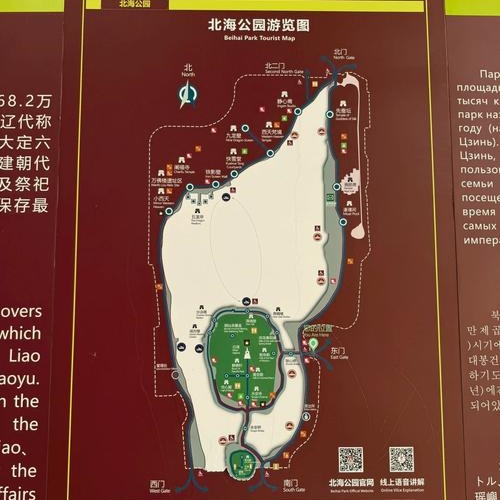
Beihai Park Map
Where Exactly Is Beihai Park?
Beihai Park sits right in the heart of Beijing, at No.1 Wenjin Street, Xicheng District. You’ll find it surrounded by landmarks like the Forbidden City to the east and Jingshan Park to the north — meaning you can easily add it to your central Beijing sightseeing route. Its lake, bridges, and pavilions form part of the city’s ancient landscape, making it both peaceful and incredibly convenient for travelers exploring nearby heritage spots.
When Should You Visit — And How Late Can You Stay?
Time Table of Beihai Park:
| Season | Opening Hours | Last Entry |
|---|---|---|
| Peak (April 1 – October 31) | 6:00 AM – 9:00 PM | 8:30 PM |
| Off-season (November 1 – March 31) | 6:30 AM – 8:00 PM | 7:30 PM |
Timing your visit matters — the park’s rhythm changes beautifully between these seasons. Keep in mind the White Pagoda closes at 5:00 PM, and the Nine-Dragon Wall stops admission at 4:30 PM. If you plan to see both, go early so you can enjoy the lake at sunset without rushing.
Tickets Table of Beihai Park:
| Visitor Type | Peak Season | Off-season | Required ID / Notes |
| Adults (Foreign Travelers) | 10 RMB | 5 RMB | Passport required; pay via WeChat Pay, Alipay, or Trip.com |
| Children (under 1.2m) | Free | Free | Must be accompanied by an adult |
| Seniors (over 60) | Free | Free | Passport or valid ID for age verification |
You can book tickets through the “Changyou Gongyuan” WeChat mini-program for convenience.
How Do You Get There Easily?
Transpotation Options of Beihai Park:
| Transport Mode | Routes | Destination Station | Notes |
| Bus | 5 | Beihai Station | Most convenient route for main gate access |
| Metro | Line 6 | Beihai North Station | Closest to Jade Flower Island |
| Taxi / DiDi | N/A | Direct gate drop-off | Convenient for foreign travelers |
Reaching Beihai Park is simple and foreigner-friendly, with clear signage and easy transport connections.
All entrances have clear English-Chinese signs, and rideshare apps like DiDi or taxis can drop you directly at the gates. It’s one of the easiest parks in Beijing to navigate — no matter which direction you come from, Beihai welcomes you with open paths and calm views.
Beihai Park Tips for Foreign Travelers
1. Speak Smart, Connect Better
Learning a few basic Chinese phrases makes your visit smoother. Save common ones like “Where is the restroom?” or “How much is the ticket?” on your phone. If you get stuck, use Google Translate or Baidu Translate — they work well for quick chats. At the South Gate, you can rent an English audio guide for about 30 RMB, with a 200 RMB deposit. Some park staff know simple English, so a smile and clear gestures go a long way. Downloading offline maps before entering also helps when the signal gets weak around the lake.
2. Respect the Culture, Enjoy the Vibe
Beihai Park blends daily life with old traditions, so a little etiquette goes a long way. Don’t touch relics like the Jade Buddha or Nine-Dragon Wall, and check for “No Photography” signs in temple areas. Locals often do tai chi or sing opera near the pavilions — watch quietly and ask before joining. When incense burns near the White Pagoda, avoid loud talking. Beihai’s calm rhythm comes from mutual respect, and being mindful lets you experience that local peace fully.
3. Pack Smart and Stay Safe
Bring what fits the season. In summer, wear light clothes, sunscreen, and a hat — the sun hits hard on Jade Flower Island. In spring, carry an umbrella for surprise showers. During winter, bundle up; the breeze by the lake can be freezing. Wear non-slip shoes since paths can get slick after rain. Keep your passport with you, as it’s sometimes required for ticket checks. If you need help, tourist centers are near the South Gate, North Gate, and Five-Dragon Pavilions, or you can call 010-64031102 for English assistance.
FAQs of Visiting Beihai Park – What Travelers Often Ask
Q: Is Beihai Park good for a half-day visit or should I plan a full day?
You can explore Beihai Park comfortably in about 3–4 hours, but if you plan to include nearby spots like Houhai or Jingshan Park, make it a full day. Many travelers prefer a relaxed pace to enjoy the lake views and local snacks. It’s the kind of place where slowing down makes everything feel better. You might even find time slipping away as you explore hidden corners. Bring a picnic or rent a small boat for the perfect half-day break. Every path leads to another quiet surprise waiting by the water.
Q: Can I visit Beihai Park in winter?
Yes, and it’s actually charming. The lake often freezes, and locals skate on it. Some areas close earlier, so check hours before visiting. The White Pagoda looks magical under snow. Bring warm clothes and a thermos of tea for the best winter walk. The park feels like a quiet world apart during cold days. Try a cup of hot soy milk from a nearby stall for warmth. The frozen lake views create postcard-perfect scenes that photographers adore.
Q: Are there restaurants or cafés inside Beihai Park?
Yes. Fangshan Restaurant near the north gate serves imperial-style dishes, and smaller teahouses offer scenic lakeside seating. For coffee or western snacks, head out toward the Houhai area afterward. Grab a lakeside seat and watch the city unwind. It’s a refreshing pause between sightseeing and city bustle. If you have time, try the lotus pastries — they’re sweet and delicate. Many locals linger here just to chat and enjoy the gentle rhythm of the lake.
Q: Does Beihai Park have English signs or audio guides?
Most main spots have bilingual signs, but smaller corners might not. You can rent an English audio guide at the South Gate or download digital guides via Trip.com or Baidu Maps. It’s an easy way to understand the park’s hidden stories while you walk. Let the audio narrations guide you through centuries of culture. You can also join small guided walks offered by local volunteers. They share charming anecdotes that make history feel alive.
Q: What’s the best time of day for photography?
Morning light is soft and peaceful, especially around Taiye Lake. For vibrant colors, 4:00–5:30 PM offers golden reflections near the Five-Dragon Pavilions. Avoid midday when the sun is harsh. Stay until evening if you want dreamy reflections and fewer crowds. The calm light makes every photo feel more personal. Bring a tripod if you love detail shots. The lake reflections and temple silhouettes look stunning in both morning mist and evening glow.
Q: Can foreigners use WeChat Pay or Alipay to buy tickets?
Yes, most ticket counters and vending machines accept WeChat Pay and Alipay linked to foreign cards. Otherwise, you can pay cash at the main gate or pre-book through Trip.com. It only takes a minute and helps skip ticket lines. Keep screenshots of payment confirmations to avoid small connection issues. Ask staff for help if a payment doesn’t go through — they’re usually patient. Paying digitally is the easiest way to move quickly through the entrance.
Q: Are there restrooms and ATMs inside the park?
Several restrooms are scattered near major gates and pavilions. Most are clean and well-marked in English. ATMs are limited, so bring some cash or rely on mobile payments. Keep small bills handy for snacks and souvenirs. Even a quick stop for ice cream or tea feels like part of the park’s rhythm. Look for vending machines near the Five-Dragon Pavilions for bottled drinks. Many travelers find these little breaks add comfort to long walks.
Q: Is Beihai Park suitable for kids or elderly visitors?
Definitely. The park is stroller-friendly and has benches throughout. Kids love the pedal boats, while older travelers enjoy shaded paths and calm tea spots. Renting a boat or sitting by the lake is a highlight for all ages. It’s one of those moments that truly captures the spirit of Beihai. Families, couples, and solo travelers all find something memorable here. Try renting a pedal boat together — it’s fun and easy to handle. For older visitors, shaded benches by the water offer a calm place to rest.
